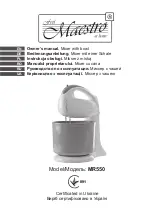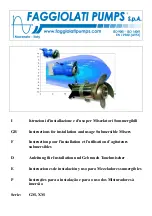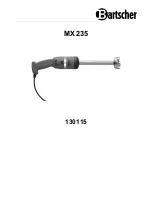
22
23
HINTS AND TIPS
FOR BETTER BREAD MAKING
Do check the ingredients and read the
•
recipe before starting to bake.
Do measure ingredients accurately
•
— weighed measurements are more
accurate than volume measurements.
Do use bread flour unless recipe states
•
otherwise.
Do check use-by-dates on ingredients.
•
Do add ingredients in the order stated
•
in the recipe.
Do store opened ingredients in airtight
•
containers.
Do
use
ingredients
at
room
•
temperature.
Don’t use flour that contains a protein
•
level of less than 11%.
Don’t use tableware cups, jugs or
•
spoons for measuring.
Don’t use hot water or liquids.
•
Don’t use self-raising flour to make
•
yeasted bread unless recipe states
otherwise.
If you live in a high altitude area above
•
900m you will probably need to alter
the yeast quantity in the bread recipe.
The higher the altitude, the lower the
air pressure and the faster the dough
will rise. Try reducing the yeast by ¼
teaspoon.
If the weather is hot and humid, reduce
•
the yeast by ¼ teaspoon to avoid over
rising of the dough.
Flour properties can alter on a seasonal
•
or storage basis, so it may be necessary
to adjust the water and flour ratio. If the
dough is too sticky, add extra flour 1
tablespoon at a time if the dough is
too dry add extra water 1 teaspoon
at a time. A few minutes is needed for
these extra ingredients to be absorbed.
Dough with the correct amount of flour
and water should form into a smooth,
round ball that is damp to the touch but
not sticky.
When hand-shaping dough for rolls,
•
weigh each piece of dough for more
evenly sized rolls.
SPONGING YEAST
Instant active dried yeast is used in the
•
recipes in this book however fresh or
compressed yeast can be substituted, if
required, for specific flavour or religious
dietary requirements.
Fresh or compressed yeast needs to be
•
‘sponged’ (fermentation started) before
adding to the other ingredients.
To substitute, use three times the
•
amount of fresh or compressed yeast
for the amount of dry yeast in a recipe.
To sponge the yeast: Place the quantity
•
of fresh compressed yeast in the
quantity of (warmed) water from the
recipe together with 1 teaspoon sugar
and 1 teaspoon flour into a clean glass
bowl, stir to dissolve and cover with
plastic wrap. Allow to stand in a warm
area (30ºC) for about 30 minutes or until
the mixture starts to bubble and froth.
This mixture should be used without
delay.
WARM AREA FOR RISING
Yeast, either when sponging or in the
•
dough, requires warmth to rise.
To create a ‘warm area’ for dough to rise,
•
place baking tray over a bowl of fairly
warm water, place prepared dough item
on baking tray, cover loosely with lightly
greased thicker-style plastic wrap or a
tea towel. Ensure kitchen is warm and
free of draughts. Allow the dough to rise
until doubled in size.
HINTS AND TIPS continued
FOR BETTER BAKING
Check the ingredients and read the
•
recipe before starting to bake.
Weigh and measure ingredients
•
correctly.
Variations may occur in raw ingredients
•
used so adjust other ingredients and
baking times if required.
Preheat oven before starting recipe
•
preparation, this will ensure the correct
temperature is achieved before baking
starts.
Temperatures and cooking times
•
may vary with some ovens so adjust
accordingly. If using a fan forced oven
reduce the temperatures in the recipes
by 10ºC.
When mixing, start the mixer at a lower
•
speed then gradually increase to the
recommended speed in the recipe
especially when adding dry ingredients.
When using smaller quantities turn off
•
the mixer from time to time and scrape
the bowl with a spatula.
Ensure wire whisk and mixing bowl are
•
clean and free of fats when whipping egg
whites as these will impede aeration.
Instead of greasing baking pans or
•
trays, line with baking paper where
appropriate. However, a little light
greasing in pans will keep the paper in
place.
Pre warm a measuring spoon in hot
•
water for easy measuring of golden
syrup or honey.
Butter should be softened at room
•
temperature to make creaming butter
and sugar easier.
Keep surfaces and ingredients chilled
•
when making, handling or rolling out
pastry. Butter for pastry making should
be kept refrigerated.
Avoid stretching pastry when rolling
•
out as it will shrink when baking. Use
light, even strokes in one direction and
avoid pressing down hard on the rolling
pin. Where possible, rest pastry in the
refrigerator before baking.
Eggs should be at room temperature to
•
give better volume when whipping
Break eggs individually into another
•
container before adding to other
ingredients to avoid potential spoilage.
Separate egg whites carefully to avoid
•
inclusion of egg yolks. Egg yolks contain
fat and will prevent successful whipping
of egg whites.
Rinse beaten egg residue from whisk,
•
beater and mixing bowl or other utensils
with cold water immediately after use.
Using hot water will set the egg and
make removal difficult.
Test if cakes are cooked at the end of
•
baking time by touching the top lightly,
the cake will spring back if cooked.
A fine skewer can also be inserted
carefully into the centre of the cake, if it
comes out clean the cake is cooked.
For crisper results when baking biscuits,
•
remove the baking trays from the oven
and place directly onto wire racks.
Move the biscuits slightly away from
their baked position on the trays and
cool completely before removing.
Содержание donna hay BEM800DH
Страница 1: ...Wizz Planetary Mixer Instruction Booklet BEM800DH ...
Страница 34: ...66 67 notes notes ...













































